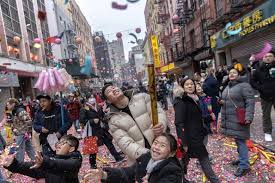Lunar New Year, also known as Chinese New Year or Spring Festival, is a significant and widely celebrated holiday in many Asian countries and communities around the world. The festival marks the beginning of the lunar calendar and is a time for family gatherings, feasts, cultural performances, and various traditions that symbolize good luck, prosperity, and the anticipation of a new year. In this article, we will explore how Lunar New Year is celebrated in different parts of the world, highlighting unique customs, rituals, and festivities that make this holiday a vibrant and cherished occasion for millions of people.
- China:
Lunar New Year holds immense cultural and historical significance in China, where it originated. The festivities last for 15 days, beginning with the New Year’s Eve dinner and culminating in the Lantern Festival. The celebrations include fireworks, dragon and lion dances, red lanterns, and the exchange of red envelopes containing money as a symbol of good fortune. Family gatherings, elaborate feasts, and the cleaning of homes to sweep away bad luck are also integral parts of the Chinese New Year celebrations.
- Hong Kong:
In Hong Kong, Lunar New Year is celebrated with a mix of traditional customs and modern festivities. The city comes alive with vibrant decorations, flower markets, and lion dance performances. One of the most famous events is the International Chinese New Year Night Parade, featuring dazzling floats, acrobats, and cultural performances. The Lam Tsuen Wishing Trees, where people write their wishes on paper and tie them to the trees, are also popular attractions during this time.
- Taiwan:
Lunar New Year celebrations in Taiwan are marked by various traditions and activities. Families gather for reunion dinners and visit temples to pray for blessings in the upcoming year. The Pingxi Sky Lantern Festival is a highlight, where thousands of paper lanterns are released into the sky, carrying people’s wishes and hopes. The Dajia Mazu Pilgrimage, a religious procession honoring the sea goddess Mazu, is another significant event during Lunar New Year in Taiwan.
- South Korea:
In South Korea, Lunar New Year is known as Seollal and is one of the country’s most important holidays. Families gather to pay respects to their ancestors, perform ancestral rituals, and share a special meal called “seollal tteokguk,” a traditional rice cake soup. Children receive money in colorful envelopes called “sebaetdon” from their elders. Games, folk performances, and kite flying are also part of the festivities.
- Vietnam:
Lunar New Year in Vietnam is called Tet Nguyen Dan and is a time of great joy and reverence. Families clean their homes, decorate with peach blossoms, and prepare traditional dishes such as “banh chung” (sticky rice cake) and “dua hanh” (pickled onions). Dragon and lion dances, fireworks, and the exchange of lucky money are common during Tet. The flower markets in Hanoi and Ho Chi Minh City are popular attractions, where people buy flowers and plants to decorate their homes.
- Malaysia and Singapore:
Lunar New Year, or Chinese New Year, is celebrated with much fanfare in Malaysia and Singapore, where a significant Chinese population resides. Festivities include lion and dragon dances, cultural performances, and vibrant street decorations. The Chingay Parade in Singapore, featuring colorful floats and cultural groups, is a major highlight. Families come together for reunion dinners, exchange mandarin oranges for good luck, and visit temples to offer prayers and seek blessings.
- Indonesia:
In Indonesia, where the Chinese community is significant, Lunar New Year is known as Imlek and is celebrated with various customs. Families gather for reunion dinners, visit temples, and set off fireworks to ward off evil spirits. The Barongsai, a lion dance performance, is a common sight during Imlek, symbolizing good luck and fortune. Red envelopes containing money are exchanged, and traditional delicacies are prepared and shared.
- Thailand:
Lunar New Year, or Songkran, is celebrated by the Thai-Chinese community in Thailand. The festivities include merit-making ceremonies at temples, dragon parades, and cultural performances. People visit their elders to pay respects and seek blessings. The highlight of the celebrations is the Songkran Water Festival, where people engage in water fights and sprinkle scented water on each other to wash away misfortunes and welcome the new year with a fresh start.
- United States and Canada:
In countries with a significant Asian diaspora, such as the United States and Canada, Lunar New Year is celebrated with great enthusiasm. Chinatowns come alive with colorful decorations, street parades, dragon dances, and cultural performances. Festivals featuring traditional music, dance, and food are organized, allowing people from different backgrounds to experience the vibrant traditions of Lunar New Year.
Conclusion:
Lunar New Year is a time of joy, family reunions, and cultural celebrations that span across different countries and communities around the world. The customs, rituals, and festivities associated with Lunar New Year are rich in symbolism, promoting goodwill, luck, and prosperity. From China to the United States, Lunar New Year is a time when people come together to honor their heritage, share delicious food, exchange blessings, and create lasting memories. The diverse celebrations of Lunar New Year reflect the multicultural fabric of our global society and serve as a reminder of the rich cultural traditions that connect us all.
